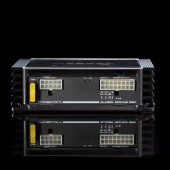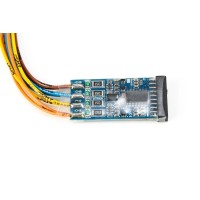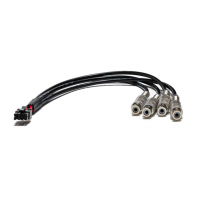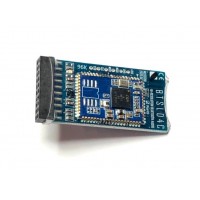Mosconi Gladen PICO 6|8 DSP amplifier
6-channel amplifier of micro dimensions, 4 x 50 + 2 x 90 W RMS at 4 Ω, class D, integrated DSP processor
More about the product
More about the product
Mosconi Gladen PICO 6|8 DSP amplifier
The Mosconi Gladen PICO 2.0 became a bit of a sensation in 2015. That's why Gladen decided to significantly expand this range with additional models of Mosconi Gladen PICO amplifiers. At the end of 2020, a new micro amplifier with a PICO 6 - 8 DSP DSP processor came onto the market. 150 x 133 x 46 mm are its dimensions, thanks to which it will not be a problem to find a suitable place in the car so that it hides and is not seen. PICO amplifiers use Class D technology.Key features of the Mosconi Gladen PICO 6|8 DSP amplifier
- Perfect integration on original car radios.
- A powerful compact amplifier optimized for use with a factory car radio.
- Six analog inputs up to 30 V, 3x EQ input and time correction.
- With a power of 4 x 50 W RMS + 2 x 90 / 120 W RMS ideal for active and semi-active systems, as well as classic front + rear speaker + subwoofer.
- With two digital inputs (SP-Dif and BT+) and two processed outputs, it is ready for the future.
| Catalog number | PICO 6|8 DSP |
| Brand | Mosconi Gladen |
| Links | Official web presentation |
| Number of amplifier channelsAmplifiers are divided into: - Monoblocks - 2-channel - 3-channel - 4-channel - 5-channel - 6-channel - multi-channel Each channel is used to power one speaker for the coaxial type, or one side if they are component speakers. Monoblock type amplifiers are mainly used for subwoofers. 2-channel are suitable for both subwoofers and, for example, the front pair of speakers in a car. 3-channel is used for front or rear speakers + subwoofer. 4-channel are used for front + rear speakers or 1 pair of speakers + subwoofer. 6 or 5-channel are used for 2 pairs of speakers + subwoofer, most often. Bridging means connecting the amplifier to a bridge, using the + pole from one channel and the - pole from the other channel. In most cases this is shown as "BRIDGED" on the amplifier. | 6 |
| Energy class of the amplifierAmplifiers are divided into two basic classes: analog and digital . Analog amplifiers (A/B) have higher consumption requirements, but usually have a more natural sound. Digital amplifiers (D) have significantly lower consumption and higher efficiency, but the sound may not be as faithful as with classic analog amplifiers. | D |
| RMS power into 4 ΩRMS power when loading speakers or subwoofer at 4 Ω. RMS power is the constant power of the amplifier and is one of the most important parameters when choosing an amplifier. | 4 x 50W + 2 x 90W |
| Input sensitivityIn order for the amplifier to perform its function correctly, it requires an input signal of a certain level, which is different for car radios. It is measured in "Volts" (e.g. 2 V, 4 V, etc.) The higher the value at the output of the pre-amplifier, or car radio, the less demands are placed on the power of the amplifier. However, the amplifier must allow this input sensitivity, and for that reason this value is also given for the amplifier. | 0.3 - 15 V |
| On-board voltage rangeThe ability of the amplifier to operate at a specified voltage. As the voltage decreases, so does the power of the amplifier. The ideal voltage in a car is between 13.8 and 14.4 V. | 10 - 16 V |
| High level inputsThe high-level input on the amplifier allows connection directly to the existing speakers in the car without additional purchase of an external high/low adapter. Important equipment in the case of installing an amplifier on an original car radio. | Yes |
| Automatic on and offThis function allows you to automatically switch on the amplifier. | Yes |
| Remote control included in the packageSome models of amplifiers also come with wired remote controls in the package, which on one side plug into the amplifier and on the other side you have a potentiometer that you can place anywhere in the cabin. A common place to place the remote control is under the steering wheel. The advantage is the regulation of power, and therefore volume, depending on driving conditions and the mood of the crew in the car. | No |
| The value of the fuses on the amplifierFrom the value of the fuses on the amplifier, you can get a true picture of the real performance of the amplifier. | 1 x 20 A |
| Dimensions of the amplifier | 150 x 133 x 46 mm |
| Mass | 800 g |
Product comments
Evaluation
ask us











